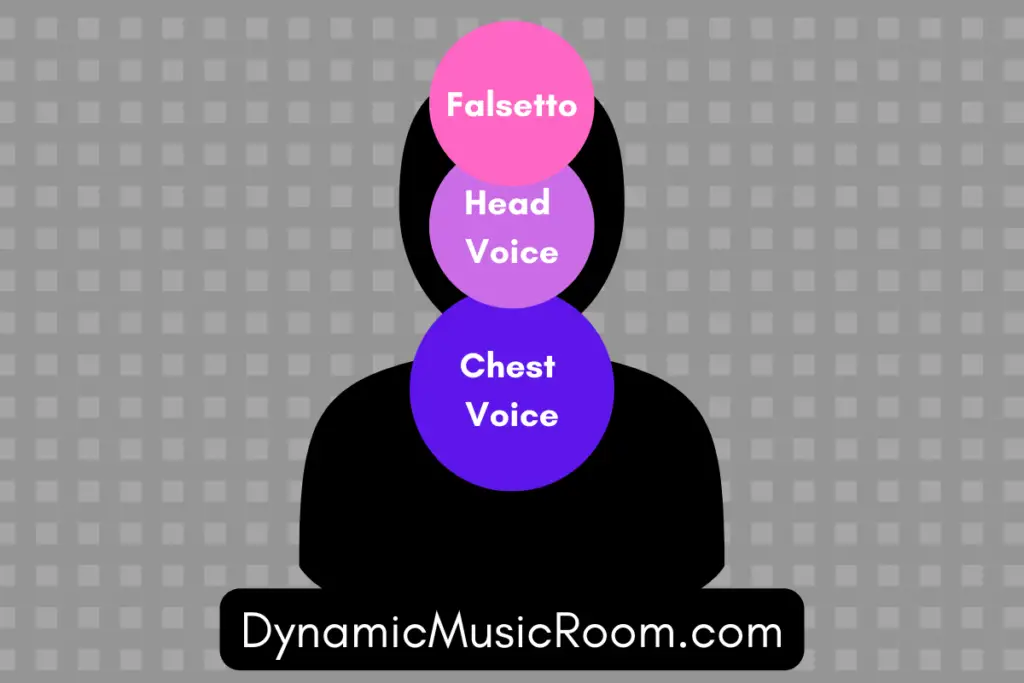As a music teacher and someone with singing and vocal training, I often take it for granted when I use words like head voice, chest voice, and falsetto.
Of the two, I’m often asked about the difference between head voice vs. falsetto and what it means to singers.
Head voice is a stronger but lighter voice than chest voice, and it’s usually a mix of the two. It’s what most females and kids sing in when they sing well. The falsetto is a thinner tone that uses the upper register and pure head tone of the vocal folds to vibrate.
This simple definition captures the heart of the difference, but it’s a big topic.
Let’s dig into a bit more examples and descriptions to offer a more detailed answer.

Get all the experience of singing lessons at a fraction of the price (and at your own speed) with 30 Day Singer.
Table of Contents
Head Voice Vs. Falsetto Quick Chart

What Is Head Voice?
Head voice is the term reserved for singing with a mixture of head and chest voice.
Often this is a lighter tone than chest voice, with a higher range.
Still, the power of the chest voice comes through.
Female voices and children’s voices are often best served in head voice, though tenor voices and countertenor voices will use it a lot as well.
Baritone and bass voices spend more of their time in chest voice with a mixture of head and chest voice as they sing higher.
The truth of the matter is: there is no standard definition in the vocal pedagogy world or in the scientific one either.
It’s used to describe all of the following:
- A higher vocal range or register of a voice
- A space for vocal resonance
- The quality of a vocal tone
The use of the term, head voice, or head register has been around for almost 2,000 years, but it wasn’t until the past 200 hundred years when the internal understanding of the vocal folds or vocal cords developed enough to provide a clearer idea.
Head voice is generally used to refer to singing in the upper range of someone’s voice while still sounding strong.
A lot of singing teachers or vocal coaches use the image of sending the sound through your forehead to help a student understand the placement of the voice better.
Look ahead for an example of head voice and falsetto side by side.
What Is Falsetto?
Falsetto is used by most people to mean a voice that is “artificially high” or a “false voice.”
The truth is, falsetto is a legitimate type of voice and singing, though it’s not very popular by today’s standards.
A falsetto voice is typically used by men when they sing, using only their head voice placement.
Many refer to it (wrongly) as the “girl’s” voice or a “women’s” voice because it sounds light and airy.
While a male voice gets the attention of this voice type, women and children have it too.
Whenever I ask my young students to sing or talk with a baby voice, they go right up to this falsetto.
And yes, in young kids, it’s pretty abrasive (but good practice for their vocal cords).
Falsetto uses only the higher register, so it lacks the power that a mixture of chest and head voice does.
As such, it’s very thin and can’t be used to sing loudly.
Essentially, if you sing higher than normal and feel a dip in your volume and tonal power, you’ve reached your falsetto voice.

Get all the experience of singing lessons at a fraction of the price (and at your own speed) with 30 Day Singer.
Is Falsetto Bad?
While falsetto isn’t usually desired in most styles of music, it isn’t “bad.”
As a male elementary music voice teacher, I used falsetto on occasion to sing in the appropriate range for my young students.
Tenors in popular music have been using it more and more lately during soft, high parts of their songs.
Think about the high note in the chorus of Take on Me by A-ha.
It’s the perfect example of falsetto.
Related Reading: Best meme songs (massive list)
Vox did a great video covering the use of falsetto over the years.
Check it out below.
Head Voice And Falsetto Example
I love to talk about musical things, but let’s be real:
Sometimes the only way to explain it is to hear it.
With this in mind, I found the great video a while ago, and it helped my students understand this tricky subject a whole lot better.
Tips For Accessing Falsetto Voice
If you want to extend your singing and range, it’s helpful to practice falsetto routinely.
While you may not want to use it regularly in your singing and performing, it does isolate a specific way your vocal folds work (namely, how they vibrate without fully closing for falsetto).
This strengthens those particular muscles and makes mixing and strengthening your full head voice much easier.
Sirens
Vocal sirens are a great way to use falsetto and strengthen those muscles.
Sirens are a non-specific pitch exercise where you sing from high to low on a specific syllable or with a specific sound.
Using sirens instead of words or specific pitches will make you more aware of at what point your voice naturally wants to switch from chest to mix to head to falsetto.
My favorite sirens are lip bubbles.
Put your lips together and blow air through them.
Then sing while imagining the “ee” vowel.
Start anywhere middle-low in your vocal range and go up as high as you can and then back down.
Bonus points if you use your arm and hand to follow the range of your voice while you sing!
When you start singing high, you’ll feel your voice start to strain a little.
If you back off on your power and imagine the sound “flipping” to go through the top of your head, you’ll naturally switch to your falsetto.
Little Kid Voice
People access their falsetto all the time, but they’re often embarrassed to do it while singing.
It often shows up when they imitate little kids or talk like a baby.
The voice you use for this is most likely falsetto.
Now, you just have to use a little more air and sustain the note, and BAM! you’ve got your falsetto.
Think Easy Breezy
For those who try to use their falsetto intentionally, you may run into the problem of instead forcing your head voice into higher and higher ranges.
When you sing high with a mixed voice or head voice, this is called belting.
It’s a huge use for many singers, but especially in the musical theatre world.
Think Idina Menzel, whom you may know from Wicked, Rent, or Elsa from the Frozen movies.
When she sings high, it’s not quiet, right?
It’s powerful.
She’s using air, muscles, and control to send her voice into the stratosphere.
But falsetto isn’t that.
It’s easy breezy.
If you’re singing high and feel a lot of tension and strain, back off.
Literally use the words “h-easy breezy” in this range, and your voice will eventually switch over.
Then, once you find it, it’s easy to do over and over again.
(Yes, put an H sound on the front of “easy” for better access to falsetto.)
Sing OOH or EEE Vowels
Open and light vowels are best for finding your falsetto, and they’ll also help you put more sound out of this thin vocal register.
Ooh and EE are the best for the falsetto register, so alter any vowels you’re singing toward these two a little bit for more success in falsetto singing.
Can Falsetto Damage Your Voice?
Falsetto will not easily damage your voice.
If you overdo it with power or sing in it all the time, it’ll make your voice tired like any other singing will do, but it’s not more prone to damaging your vocal folds.
In fact, because it’s more gentle in energy and dynamic, it may even help you sing longer and longer!
Do Females Have Falsetto?
Female voices and children’s voices also have falsetto, though its use is limited as their voices are already higher with head voice range in general.
Pop singers (sopranos like Mariah Carey and Ariana Grande as examples) use falsetto for their higher range fairly often for those soaring notes.
The falsetto is usually harder for the average person to spot compared to their head voice because female voices are usually a little lighter in tone than male voices.
The contrast is smaller, so it’s harder to spot.
With kids’ voices, it’s even worse. Their falsetto is almost impossible to spot, and I see it most often when they are making baby voices or joking voices.

Get all the experience of singing lessons at a fraction of the price (and at your own speed) with 30 Day Singer.


